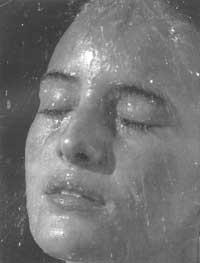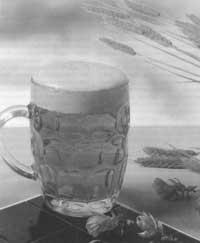Be thirsty
In industrialized countries water and the rest of drinks are obtained quite easily and often we forget the importance of drinking. But thirst causes one of the most important behaviors that helps maintain the balance of our internal environment: drinking. Various parts of our body sensitive to the degree of hydration emit nervous and hormonal messages.

Our specialized brain centers integrate, interpret and give adequate response to the different messages received (expressing and/or inhibiting thirst so that the water reserve of our body is always something above). However, there are other external elements or factors that are mixed with the internal messages produced by dehydration. For example, just as a pleasant taste can induce to consume more water, water pollution is usually the cause of low consumption.
The normal volume of water of a person weighing 70 kg is 50 liters. Thus, water represents almost 70% of its weight. However, at all times we are eliminating this water, either by renal excretion, or by pulmonary evaporation (and especially by sweat, which is the greatest loss of water). These water losses are those that generate a hydromineral deficit in our body and make us feel thirsty. Thirst leads us to drink enough water to correct this possible imbalance. Therefore, a person should drink 2.5 liters of water a day in normal conditions, but in summer, in the desert and after a major effort, he should drink 10-12 liters.
The body has a system of detection of water scarcity to cover its water needs. This system generates thirst and generates a disotic behavior that promotes water uptake. The latter is a well-studied behavior. Specialized body cells begin to know stimuli that provoke a reaction to the lack of water, nerve centers involved in the hormonal signal and all stages or phases of the process that generates thirst. In addition, it is possible, at least experimentally, to modify the final behavior by participating in each of these phases both in the laboratory and in the clinic.
Although thirst is subjected to strict physiological control, the organism has some “tolerance” or “indulgence”. For example, with the same thirst, you can drink less or more. In addition to polydipsia (ingestion of an excessive volume of water) and adipsis of psychiatric origin (absence of thirst), there are other deviations in the consumption of liquids, less serious, but of long duration and that can affect health. They are usually related to high blood pressure or to the weakness of certain people, especially elderly people who live in chronic dehydration.

Why and how do we drink? Drinking is an act or behavior that we must base on the mechanism of thirst to understand. However, this behavior cannot be understood at all if external factors that are mixed with the internal or physiological factors that our organism responds are not taken into account. We are aware that drinking has become not only a necessity, but a pleasant action that often pushes us to drink, even if it is not thirst.
The most representative example of drinking without physiological need is that of alcoholic beverages, in which water only appears as a solvent. The desire or desire to consume solute is often what we mix with thirst. However, there may be other alternatives for drinking alcohol, such as food. What if the only way to drink alcohol was food? The saturation of the organism would be immediate, limiting alcohol consumption. But we have mentioned that the tolerance of the organism regarding the consumption of liquids is different from that of the consumption of food.
A person can drink a lot of liquid without water poisoning. Water poisoning occurs when the kidneys cannot remove the excess water the body has, because it has been drunk too quickly (5-6 liters in 3 hours) and causes the brain cake, coma and death.
The main reason for tolerance to excesses lies in renal function; in the ability to adapt this function. The hyperhydration produced from the moment in which water consumption exceeds the needs of the organism, acts on the hormones that control the flow of urine or diuresis, increasing proportionally the amount of urine and diluting at the same time. The adaptation of the diuresis also occurs in the opposite direction. In cases where water consumption is poor, the kidney is able to reduce consumption by concentrating txixa and limiting the amount. In this sense, however, we arrive faster to the limit situation, since by reducing the flow of urine also decreases the capacity of the kidneys to remove toxic substances.
Consequently, the kidneys must work more to deposit the residues of the organism and, in the long term, it is harmful. It is clear that when a given situation is reached, water scarcity can only be solved by drinking water. This relative “tolerance” is the reason a person can drink a few liters or a small amount of liquid before a dehydration, depending on whether the taste of the drink is pleasant or not.
It is the function of the kidneys that allows our organism to adapt, at least in part, in conditions of dehydration or hyperhydration. However, the behavior of thirst is oriented to ensuring a precise regulation of certain physiological functions. The water flows of our organism ensure that the composition of what Claude Bernard called the interior environment remains constant.

French physiologist XIX. Thanks to what he taught in the mid-twentieth century, we know that the functioning of our organism, although external factors and conditions are inadequate and changing, remains in an optimal state. This independence with the external environment is achieved thanks to other behaviors aimed at regulating the intake, homeostasis and the constancy of the interior environment, which allow the cells of the organism to function properly maintaining constant the composition of the medium.
Physiological thirst
The volume of water of our organism is divided into different parts or places. Hydration is maintained within tight limits on each part of the body. These parts are the intracellular space (a person weighing 70 kg has between 32 and 35 liters in cells), the intercellular space and blood plasma, maintaining the balance between these last two. The situation of each of these spaces is maintained individually through renal function and the adaptation of thirst. Therefore, thirst would have two components or sources, one corresponding to the dehydration of the intracellular space and another to the extracellular space and vascular space.
In the outside environment there are also salts, mainly sodium and potassium, whose concentration must be kept constant. The distribution of water between intracellular and intercellular spaces is due to osmotic pressure generated by the difference in concentrations of salts on both sides of the cell membrane. The objective is to make the water pass from space of less concentration to that of greater concentration. The cell membrane contains pump-like elements that collect potassium inside the cell and sodium outside it. Thus, if the food increases the amount of sodium or the organism suffers lack of water, the intercellular space becomes hypertonic (excessively concentrated) and the water moves out of the cell, leaving the dehydrated cells.
To cause thirst in an adult, it is sufficient to increase the plasma sodium concentration by 2%. On the other hand, if the leftover is potassium, the opposite occurs: water enters the cell. However, a simultaneous loss of water and sodium may occur, as a result of deep sweating. Then, although the intercellular volume decreases, the sodium/water ratio remains constant, so no intracellular water is taken.
Intracellular and intercellular dehydration detection mechanisms are independent. Both mechanisms provoke thirst to correct the imbalance produced. In general, thirst is mixed, that is, formed by these two types of thirst. They are specialized cells that detect signs of dehydration and communicate to the nervous center responsible for causing thirst by sending nervous and hormonal messages. After several attempts to locate intracellular dehydration detectors, in 1942 some Parisian neurosurgeons managed to locate the diotic centers in the later hypothalamus. The hypothalamus is a hidden part of the brain in front of the pituitary, where control systems are located involved in behaviors such as hunger, sexuality and aggression.

The problem of the localization of the diotic centers has experienced great advances, B. Thanks to the work of Andersson, since the 1950s. This introduced a small amount of sodium to the hypothalamus of a goat. The answer was free. The goat began to drink water without interruption. Therefore, the state of dehydration of the cerebral receptors is the one that causes a reaction to excess sodium or the lack of water in the intercellular space.
There is another system of detection of excess or lack of water. This system also reacts with changes in salt concentrations, but controlling the elimination of kidney water. It works by adapting the production of antidiuretic hormone or vasopressin that produces the pituitary to increase the absorption of renal water. Sometimes this system is deteriorated by a tumor. In these cases, the production of urine is enormous and the ability to compensate for this loss of water in urine with enormous amounts of liquids allows its survival. If the system that controls thirst were the same one that controls diuresis, the malfunction of one would also affect the other and it would be impossible to survive.
Why drink and sometimes take salt?
Let's see what happens when there is bleeding, diarrhea, or deep sweating. In these cases the losses of water and salts are produced in the same proportion, so the concentration of salts in the interior environment does not vary. However, the lack of water causes a great thirst. This is the thirst of the wounded in the war or those who have internal bleeding. The first answer to this situation is to drink a certain amount of water. We replace the lost volume, but not the sodium chloride lost by sweat or blood. Therefore, when drinking the plasma is diluted, the salt concentration decreases and the water moves towards the inside of the cell, the cell grows and produces a sign of inhibition.
In other words, as the cell resolves the lack of external water, it occurs in excess of water inside the cell. Due to the inhibition of this excess of water, we stop drinking, although with sweat we continue to lose water and sodium chloride. Soon after, the person is totally dehydrated (despite having the bottle full of water in front, without wanting to drink, and in some cases, the person will also turn him/her). This phenomenon was called E.F. dehydration desired Adolph, American physiologists.
This dehydration and its weakness caused great damage to US troops not accustomed to the Pacific climate, as well as to German and allied troops during World War I in Africa. R. R. F. F. Thanks to Adolph, the Americans solved the problem just knowing the physiological mechanism of thirst, which consisted of a greater amount of salt in food. This remedy is also valid for anyone who moves south of the northern countries and for athletes who need to be sweating for a long time.

When dehydration occurs in the interior environment, a set of mechanisms that make us feel thirsty begins. But even if it seems surprising, the thirst begins to quench as soon as the water is drunk, that is, when it is in the stomach, not yet reaching the inside. After analyzing the neurons involved in the regulation of hydromineral balance, it has been observed that these neurons, which receive messages about the hydromineral state of the interior environment, also receive messages from the external medium by the tongue and stomach. These external messages join the inmates and neutralize them until the water reaches the interior environment.
Reason why less water is consumed
The mechanisms described in this article are subject to environmental conditions. When we have enough water and there is no danger of drinking, physiological thirst will hardly appear, we drink before feeling thirst, avoiding dehydration. Likewise, we will try to drink as little as possible when water consumption poses a risk (for example, intoxication). After several studies it has been possible to verify that it is learned to condemn liquids and solids containing toxic substances. Since urban waters are contaminated in many cases, we should begin to wonder if we are not facing a kind of water repulsion.
According to a recent study on the water consumption of the inhabitants of Paris, the consumption of all liquids (excluding alcoholic beverages), water, coffee, tea, etc. is 1.15 liters per day. The friendly component of drinks can induce to consume more liquids to cope with the same thirst, being able in some cases to consume between 2 and 3 times more. This makes the hydration of our organism to be at a level of balance or slightly above it. This situation improves the function of the kidneys and increases the possibilities of survival of the species; before a serious lack of unpredictable water, the existence of the water reserve of the organism above allows a longer duration.
Long efforts. Drink before feeling thirsty.
In May 1983, the Paris Marathon was held in full sun and there were numerous runners who suffered severe insolations. Three of them died. From that moment, in the races of this level, the start is about 4 in the afternoon. However, the outside temperature is not the only cause of this heat shock, the highest risk for the athlete who makes long-lasting efforts. From the knowledge of the mechanisms that regulate the hydromineral balance, the doctors specialized in the world of sport have given simple guidelines to take into account in the training, in the own race and in the post-test recovery.
These standards are summarized in two simple actions: moisturizing and salting. When an individual passes from the step to an important effort, body temperature increases proportionally depending on the effort or work done. Then he begins to sweat. The sweat, by surface evaporation, cools the organism. During the effort the sweat can be 1 or 2 liters per hour and carries with it 0.5 to 3 g of sodium per liter.

The risks of dehydration and loss of sodium, electricians who can affect any body muscle, extreme fatigue, headaches, dizziness, and loss of knowledge are a syncope of heat and a focus of heat. The person suffers a sudden decrease in tension and can stay in a coma. All these accidents can be treated with a rehydration with salt solutions and cooling the body if necessary. But, of course, these accidents need to be monitored in advance, being indispensable condition to prepare them properly for the test. With a good training it is possible to reduce sweating and the loss of salt concentration with sweat. At the same time, training should be used to achieve a good hydromineral balance. Doctors recommend drinking lightly salted water (0.1%-0.15% sodium chloride) at meals or every hour or taking salt tablets (13-15 g/day).
The duration of the test and climatic conditions are factors to take into account. In prolonged tests, for example, when you are on sweat legs, it is necessary to take salt also during the test. The athlete must drink at regular intervals and less than 400 ml each time. It is very important not to wait to feel thirsty, since this feeling is less and less as the effort increases. If you feel thirsty, we will have a water imbalance that cannot be overcome in the test. It is recommended to drink salty drink after effort to restore broken hydromineral balance. However, in adverse weather conditions, when there is a lot of heat and humidity, things are complicated.
Sweat is usually large, but low evaporation due to humidity. In these cases, the most serious risks of hyperthermia appear. On the other hand, when the time is temperate and dry, the water evaporates quickly and being less tolerated by the effort, it can be aspirated a maximum of 800 ml per hour, it is not drunk enough, the water losses are not compensated and there is risk of dehydration. It is easy to avoid it. Just wet the body with water during the effort to refresh the body and at the same time limit sweat. This is why all the big marathons have installed showers along the route and distribute the water every five kilometers. Of course, these measures will not avoid all accidents, but certainly offers better safety conditions to athletes.





